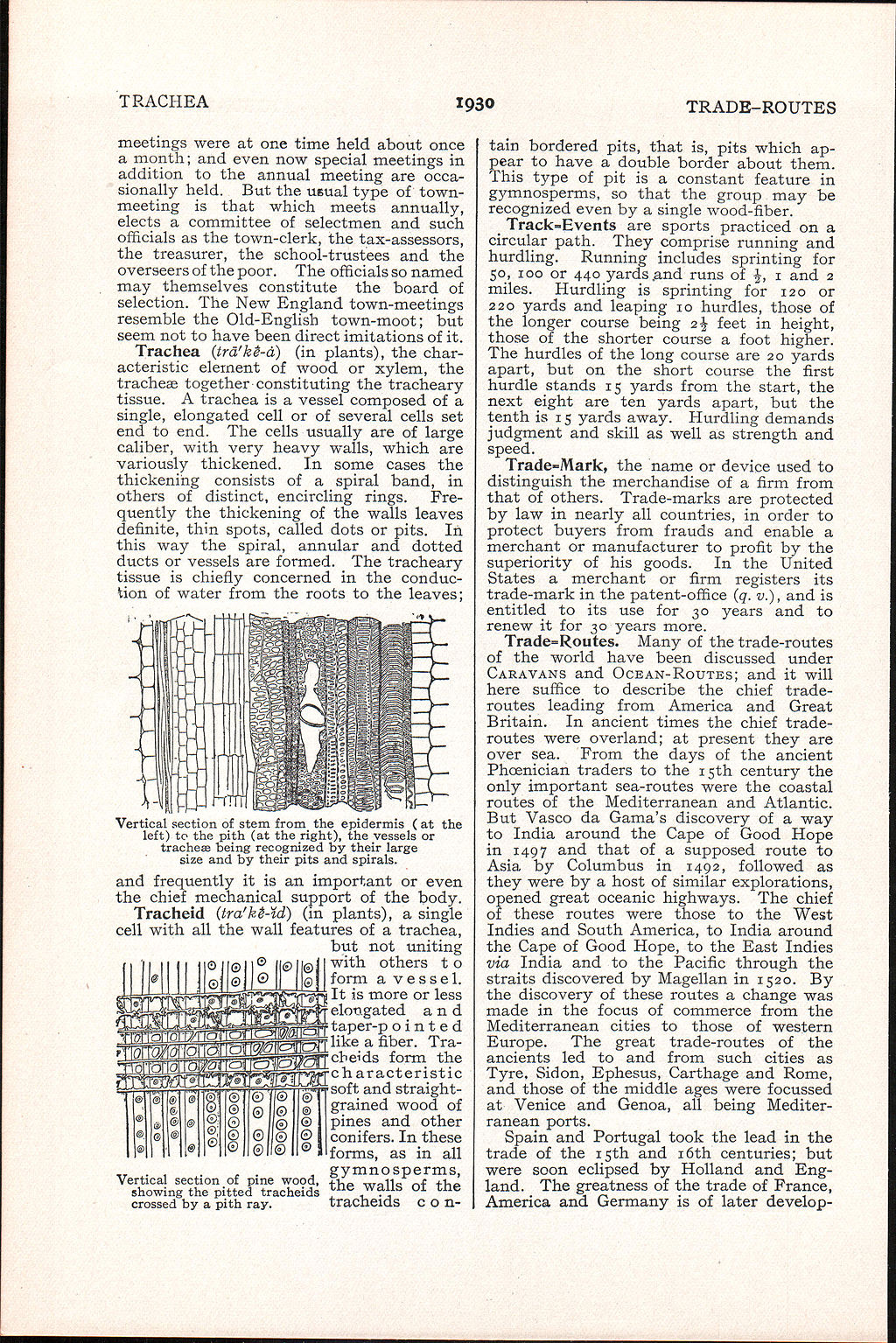meetings were at one time held about once a month; and even now special meetings in addition to the annual meeting are occasionally held. But the usual type of town-meeting is that which meets annually, elects a committee of selectmen and such officials as the town-clerk, the tax-assessors, the treasurer, the school-trustees and the overseers of the poor. The officials so named may themselves constitute the board of selection. The New England town-meetings resemble the Old-English town-moot; but seem not to have been direct imitations of it.
Trachea (trā′kē̇-ȧ) (in plants), the characteristic element of wood or xylem, the tracheae together constituting the tracheary tissue. A trachea is a vessel composed of a single, elongated cell or of several cells set end to end. The cells usually are of large caliber, with very heavy walls, which are variously thickened. In some cases the thickening consists of a spiral band, in others of distinct, encircling rings. Frequently the thickening of the walls leaves definite, thin spots, called dots or pits. In this way the spiral, annular and dotted ducts or vessels are formed. The tracheary tissue is chiefly concerned in the conduction of water from the roots to the leaves; and frequently it is an important or even the chief mechanical support of the body.

Vertical section of stem from the epidermis (at the
left) to the pith (at the right), the vessels or
tracheæ being recognized by their large
size and by their pits and spirals.

|
|
Vertical section of pine wood, showing the pitted tracheids crossed by a pith ray. |
Tracheid (tra′kē̇-ĭd) (in plants), a single cell with all the wall features of a trachea, but not uniting with others to form a vessel. It is more or less elongated and taper-pointed like a fiber. Tracheids form the characteristic soft and straight-grained wood of pines and other conifers. In these forms, as in all gymnosperms, the walls of the tracheids contain bordered pits, that is, pits which appear to have a double border about them. This type of pit is a constant feature in gymnosperms, so that the group may be recognized even by a single wood-fiber.
Track-Events are sports practiced on a circular path. They comprise running and hurdling. Running includes sprinting for 50, 100 or 440 yards and runs of ½, 1 and 2 miles. Hurdling is sprinting for 120 or 220 yards and leaping 10 hurdles, those of the longer course being 2½ feet in height, those of the shorter course a foot higher. The hurdles of the long course are 20 yards apart, but on the short course the first hurdle stands 15 yards from the start, the next eight are ten yards apart, but the tenth is 15 yards away. Hurdling demands judgment and skill as well as strength and speed.
Trade-Mark, the name or device used to distinguish the merchandise of a firm from that of others. Trade-marks are protected by law in nearly all countries, in order to protect buyers from frauds and enable a merchant or manufacturer to profit by the superiority of his goods. In the United States a merchant or firm registers its trade-mark in the patent-office (q. v.), and is entitled to its use for 30 years and to renew it for 30 years more.
Trade-Routes. Many of the trade-routes of the world have been discussed under Caravans and Ocean-Routes; and it will here suffice to describe the chief trade-routes leading from America and Great Britain. In ancient times the chief trade-routes were overland; at present they are over sea. From the days of the ancient Phœnician traders to the 15th century the only important sea-routes were the coastal routes of the Mediterranean and Atlantic. But Vasco da Gama's discovery of a way to India around the Cape of Good Hope in 1497 and that of a supposed route to Asia by Columbus in 1492, followed as they were by a host of similar explorations, opened great oceanic highways. The chief of these routes were those to the West Indies and South America, to India around the Cape of Good Hope, to the East Indies via India and to the Pacific through the straits discovered by Magellan in 1520. By the discovery of these routes a change was made in the focus of commerce from the Mediterranean cities to those of western Europe. The great trade-routes of the ancients led to and from such cities as Tyre, Sidon, Ephesus, Carthage and Rome, and those of the middle ages were focussed at Venice and Genoa, all being Mediterranean ports.
Spain and Portugal took the lead in the trade of the 15th and 16th centuries; but were soon eclipsed by Holland and England. The greatness of the trade of France, America and Germany is of later develop-
